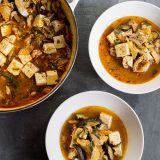To adapt a classic pork stew from Korea, we turned to a cut of meat that’s more at home in American barbecue: baby back ribs.
Salty, spicy and satisfying, kimchi jjigae is one of Korea’s most essential dishes. Savory-sour kimchi, fatty strips of pork belly and silky cubes of tofu combine with a powerful blend of chili flakes, chili paste, garlic, soy and sesame oil in a rich stew. When made at home, it’s cooked and served from a large pot set at the center of the table, accompanied by a fleet of small vegetable-centric sides and rice. At Korean barbecue restaurants, it’s often brought without request, a bold complement to a bowl of white rice.
Recipes vary from household to household, but a few ingredients—the ones that give the jjigae broth its spicy, aromatic backbone—are constant: gochujang, Korea’s umami-packed fermented chili paste; gochugaru, Korean chili flakes; garlic; a bit of sugar; and sesame oil. Shiitake mushrooms and more scallions are common additions at the end of cooking.
Some recipes start by simply putting all the ingredients, including the pork belly, kimchi and cooking liquid, into a cold pot and bringing the mix to a simmer. Others briefly sauté the pork and kimchi before the cooking liquid is added. Either way, the cooking time is usually about half an hour—just long enough to draw out depth from the kimchi, but not so long that the vegetables lose their crunch. The result is a quick stew that, in Korea, requires little more than kitchen staples.
Of course, Korean pantry staples are different from their American counterparts. At Milk Street, we knew we’d need to adjust our ingredients slightly. Kimchi and gochujang are increasingly available at mainstream grocery stores, but we ruled out gochugaru.
Pork belly presented another problem—it can be hard to find and sometimes requires special ordering. Replacing it, however, proved tricky. Tenderloin is easy to work with, affordable and always available, but the lean cut wouldn’t impart nearly as much flavor as pork belly. Ground pork would offer more fat but would require shaping—and meatballs would seem out of place in jjigae.
That led us to think that baby back ribs could be more than a cut reserved for barbecue. When braised, the meat becomes supremely tender and the flavor-rich connective tissue clinging to the bones breaks down, creating a luscious pork stock—perfect for a no-sear stew. They wouldn’t be as quick-cooking as the pork belly, but we could save some time by cutting them into individual ribs, then shredding their meat before stirring it back into the stew.
Some jjigae recipes also call for making a stock to bolster the stew’s flavor. While we liked the depth that would impart, we didn’t want to complicate an otherwise straightforward recipe. We found middle ground in simply soaking dried shiitakes in boiling water, then adding both the hydrated mushrooms and the savory soaking liquid to the stew.
For the alliums, we opted for scallions, adding the whites early and reserving the greens for later. The kimchi, too, was added in two steps: half of it early to allow it to soften slightly as the meat cooked, and half at the end to provide a contrasting crunch. We added cubes of firm tofu at the end, to give the stew even more substance.
With our ingredient bill adjusted and narrowed to just 10 items (plus water), we adhered to jjigae’s traditional method: cook, simmer, serve. The result was a rich, tangy stew that—thanks to meaty ribs and savory fermented staples—packed far deeper flavor than we’d expect from half an hour’s work. Serve it as a starter, or with a bowl of steamed white rice to make a complete meal.




